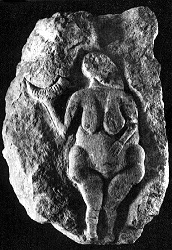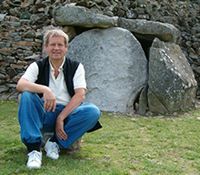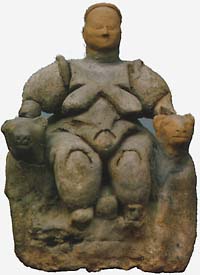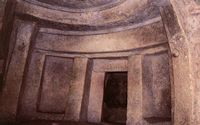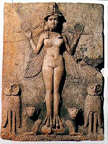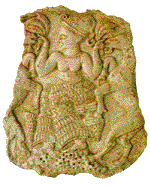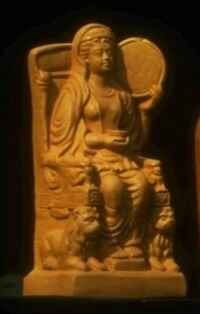Turn On!
Healing the Planet
To Begin with A New Spirituality
Her Story
UNIVERSAL MOTHER
(Mother of God, Mother of heaven and earth,
Mother of all people, Mother of animals and plants,
Mother of rocks and clouds.....)
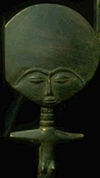 |
 |
In the beginning...was the Great Mother. She was percieved as primordial Darkness, corresponding with the awesome dark universe. There was a great intuition about this "Abyss of the universe", being the Womb giving birth to the world. In many cultures it is stated that the "The Light was born out of Darkness", the former represented by the sun, the moon and the stars. This was later confirmed by spiritual Realization, in which "The Divine is born out of Nothingness".
The astonishing thing is, that reminders of the Great Mother still can be found in all cultures - archaic, indigenous and modern - and in patriarchal religions. From matriarchal tribes in Africa and elswhere, Neolithical fertility mothers in Europe, sayings of South American Indians, womb-shaped tombs in pre-historic China, the Maha Matri as the original Great Mother of India, the Great Mother traditions of the Middle East and Egypt, the hidden Mother symbolism of Islam to the more obvious reminders in Christianity (Mary).
"EVOLUTIONARY CYCLE"
Entropy and Rebirth
The Great Mother
Paleolithic
(Vacuum, Ultimate Reality, Universal Womb, The Unity
of Death, Permanence and Rebirth)The Great Mother/Goddesses
Neolithic
(Archaic/Matriarchy/Pre-patriarchal)
Goddesses
Bronze Age
(Fragmentation of the Mothers in Destruction,
Permanence and Fertility Goddesses)
Gods
Iron Age
(Early Patriarchy)
The One God
Historical time
(Patriarchy)
A Substitute
Christ
(Patriarchy)
The Church
Degeneration
(Decay)
God is dead
Modernity
(Materialism)
Disintegration
Recently
(Spiritually, culturally, socially, economically...)Return of
The Great Mother
A New Era
(Savioress of the World)
It leads us to the (fiercely disputed) hypothesis of an ancient universal matriarchal culture, having preceded patriarchy. The Universal Great Mother Tradition aims at restoring the original Wholeness of Life, making the feminine principle the foundation of modern cultural, religious and social life.
The neolithic "Womb" of Barnanez
(Bretagne)Paleolithical Great Mother
Mythology/Mother Religions
THE GREAT MOTHER
Paleolithic
In prehistoric times, the Mother was considered the "center of the universe". The Mother was the only source of life, since the connection between pregnancy and sex wasn't known. The earth was Her manifestation, Her body so to speak. Everything was still embedded in primordial unity, to be compared with a foetus in the womb. People drew parallels between human life and other phenomena in nature. Crucial was the waning and waxing of the moon with the new moon in between. This was "symbolic" for the unity of life, in which death and rebirth are two parts of the same cycle. They compared the moon with the fertility of women, both embedded in the Dark Cosmic Mother. Maybe it is good to realize, that the Paleolithic Mother culture had a common matrix, spreading from western France to lake Baikal in Siberia and Northern China. This period of time lasted many tens (hundreds?) of thousands of years, while our current dominant (patriarchal) religion is only around seven thousand years old.
THE MOTHERS
Neolithic
Starting around 10.000 years BCE this period of time is characterized by the "invention" of agriculture (while in the previous time they were hunters and gatherers). Because in Europe the ice was melting down, people started to leave their caves to build settlements in the open. Since women were closest to the mystery of life e.g. the earth, it were them who "discovered" the laws of sowing, planting, growing and harvesting crops, mainly cereals and corn. Now the law of life, death and rebirth could be observed even more closely. Prominent findings from this period are the Indus delta, Mesopotamia, "Old Europe" (Balkans), Catal Hoyük in Turkey and Malta. The Mother Goddess of Catal Hoyük was to set the example for the enthroned Goddesses of later periods: from Isis to Cybele and from the Taoist Mother to the Virgin Mary. In the Megalithic era this culture can be found throughout Europe. It was characterized by burial tombs, temples and megaliths. They were considered to be the Womb of the Goddess, taking the souls back into Her underworld in order to prepare them for rebirth. One of the other functions of these sites was tuning in of macrocosm and microcosm through exact astronomical measurements.
Great Mother of Catal Hoyük
Crete
The Mother has been the underlying principle of almost all ("great") civilizations. Crete marks the transition between the Neolithic period and the coming Bronze Age. While on the mainland patriarchal dominance was gaining momentum - both through inner development as well as through barbaric invaders from the north - the isolation of the island favored the reign of the Goddess almost until the beginning of the Iron Age. Cretan culture marvells through its "pastoral" art, all depicting the Mother as the Goddess of life, death and regeneration. Most impressive are the small statues found in Knossos with snakes - the symbol of rebirth - around Her waist en in Her hands. Her eyes are bewildered because of the presence of the Transcendence, a very unique finding indeed.
The main characteristic of the Great Mother is unifying all aspects of life. Her Womb rules (re)birth, preservation and destruction simultaneously. As discriminating consciousness proceeded, the aspects of the Mother increasingly "started a life of their own". The Original Unity fell apart in many separate units. It was the beginning of the era of the goddesses. The Mother-goddess Isis was a transitional figure. She is both the Mother, while possessing countless different aspects. At other places and times, three categories took shape, according to the three aspects of the Mother: fertility goddesses, those who were protectresses of life and the destructive ones. Example of the first was Astarte; the second had her representative in the famous Artemis of Ephese and the third category included Lilith. Through identification with various aspects, projected in countless goddesseses and cults, the original wisdom about the Origin of the universe slowly faded away. The power of the Mother was weakened accordingly. It was under those circumstances, that patriarchy with its masculine God(s) found a "fertile ground" for its expansion.
Temple on Malta
GODDESSES/GODS
Invasions/Bronze Age
Until now the dominant culture had been that of agriculture-centered tribes. They were the descendents of the paleolithic Great Mother religion. Women still represented the wholeness of life. In everyday life they were the ones who took care of e.g. the crop cycle, cooking, child care, pottery, weaving, social interaction and the religious practices. As far as we know it these cultures didn't know armed conflict or war. Besides "male emancipation" from within - the Gilgamesj epos giving account of the males increasingly refusing to take the role of "vegetation god", instead start searching for the quest of immortality - a disaster from without would change the very foundation of a millennia-old culture. It consisted of the invasions of barbaric people e.g. the Indo-Europeans from the North and the Semites from the South. These people - a.o. descendents of the paleolithic hunter tribes - had managed to domesticate wild animals - especially the horse - a process that started around 5000 BC. Not agriculture but nomadic life characterized their doing. Hence, they did not experience a close relationship to the earth. To them the sky was most dominant. Not surprisingly though, that these people developed the concept of an all dominating sky god. While the earth was something to be conquered, rather than to live in harmony with. These tribes appeared in the goddess-cultures as Hittites (Turkey), Dorians (Greece), Akkadians (Sumeria) and Israelites (Canaan) around 3500 BC. The conseqences were devastating. In Anatolia ("land of the Mother") alone some 300 towns and cities were destroyed to the ground.
Inanna/Ishtar
Together with patriarchal rule the Mother Goddess religion was gradually replaced by gods. The first written accounts have been found in Sumer, at a time that patriarchy already made its first beginnings. "Women had the experience, men wrote it down". The Original Great Mother used to be the "Queen of Heaven and earth", the Womb that gave birth to both the Gods and the universe. She "embodied" (re)birth, preservation and death. Everything originated from and returned to Her. She was (still) the All-Embracing One. The dominant myth is that of the Son-Lover. While She represents eternity, the Son symbolizes her dynamic manifested part. He identifies himself with the well-being of the people. His main task therefore is to secure the fertility e.g. harvest. This was done through a annual ritual of death (in autumn) and rebirth (in spring). It varied from actual death, the sacrifice of an animal (usually a bull) or a purely symbolic ceremony. Big festivals were held to celebrate the beginning of a new season. This knowledge was deeply engrained in consciousness. Hence, it lasted for many centuries. Tales like Inanna and Dumuzi, Ishtar and Tammuz, Astarte/Astarte and Baal, Cybele and Attis, Aphrodite and Adonis and finally.....Mary and in the death and resurrection of her son Jesus Christ* are the prove of it.
* "Is it possible that the story of the Nativity at the beginning of the Gospels of Luke and Matthew, and the story of the trial, crucifiction and resurrection at the end of the four Gospels, actually retrace the lineaments of the far older story that belonged to the mythology of goddess Inanna and her son-lover Dumuzi?"
Anne Baring & Jules Cashford "The Myth of the Goddess" p. 177
The first Great Mother we know of through writings was Inanna (Sumer). Although some (early patriarchal) texts talk about Inanna "created by God", there is convincing evidence that She existed at "the beginning of time before anything else". She was the Origin of all things. Later Inanna turned into Ishtar, the Mother-goddess of Babylon. Through many clay tablets quite something is known about them. Especially the hymns are moving documents of the devotion people felt for the Great Mother. Under the influence of patriarchal gods and practices (separation of "heaven and earth", conquering, dominance and warfare) the old Mother-goddess gradually lost Her power. She wasn't able to maintain the unity of life, so characteristically for the tens of thousands of years before. Life and death were no longer considered to be two inseparable parts, but became opposites, excluding each other. Thus, Inanna f.i. shifted from the Goddess of love to the Goddess of war....Self-sacrifice in favor of their own people turned into "sacrificing" the enemy. Death - rather than being a place of transition toward rebirth - became irreversible, a terrifying event.
Asherah/Astarte
This conflict - that between a rude, conquering hunter-culture with their dominating Fathergod and the (relatively) peaceful Mother cultures lasts until these very days. It is the struggle between the aggressive, greedy, ruthless, expansionist capitalist system against the (reatively) peaceful common people of all continents. This system is destroying everything that comes in its way: from indigenous peoples, non-western cultures, animals, forests, plants, rivers, oceans, fishes....yes even the atmosphere. Ironically, the current "clash of cultures" is between two patriarchal systems*. The real struggle, however, is between poor people everywhere - representing the Mother - and the global ruling class. Since the existing system is in decay, the outcome of the struggle cannot be doubted.
* S.Huntington "The clash of civilizations" 2001
GODS
Iron Age/Patriarchy
Astarte/Asherah was the Mother-goddess of Canaan. It was this goddess, whom the Israelites considered their most deadly enemy *, especially because she was revered by the Israelites themselves, a.o. many women and kings (Solomon, David). The bible, in fact is a story about the struggle between the old goddess-religion and the new patriarchal masters. In the early times Jaweh still had "maternal traits", while later turning into a revengeful tribal deity. The last goddess of Babylon - Tiamat - was finally destroyed by the god Marduk. This event is symbolical for the ultimate defeat of the Mother. All Her attributes turned into a curse ("devil"). Especially the snake - the symbol of the everlasting cycle of death and rebirth - became the scapegoat. The Genesis story speaks for itself. In later centuries the (male) hero had to kill the "dragon", the symbol of "darkness" - being in fact the suppressed Mother - which had to be slain in order to be able to enter the "realm of light". In Egypt it was the Mother-goddess Isis, who has had an very long tradition indeed. Her original wholeness had been split into countless "individual" characteristics though. Astonishingly her last temple was closed in Soissons (near Paris) in the year 550 AD. In Greece the transition was gradual too. In the beginning Goddesses still occupied a major position. Demeter still gave birth to a daughter (Kore or Persephone). However, very soon they had to share their power with the Gods. F.i. Persephone was kidnapped by the god of the underworld. Demeter desperately tried to rescue her, but wasn't able to prevent, that Persephone had to spend one season every year with her "husband". While Dionysos was still a representative of the old tradition, expressed by "his" mystery religion with many women followers, Zeus appeared to be less sensitive. Very soon he became the dominant Fathergod. He wasn't so considerate anymore with goddesses. He "married", took them as his "consort" or raped them, whenever he wanted. In the Roman empire finally, the goddess Cybele had been taken from Phrygia (Anatolia) to protect Rome against Hannibal. As the "Magna Mater" She was the last one who still managed to somehow represent the original unity.
* Not by the people, but by the fanatic Levite priests! See chapter "The Bible".
"The Great Mothers' gentle contours (in Her manifestation of Durga)* serve subtly as a commentary on the sweet and calm expression of the divine face and on the graceful gesture with which the triumphant goddess exhibits the symbols of Her strength. The trophy of Her victim is sufficiently proof of Her valor. She does not insist. She simply appears, manifesting Herself for the delight of the devotee- because the victory, violent though it was, had been that of the womanly, maternal principle over the brute force of sheer vitality, which had been embodied in the buffalo-shaped tyrant. According to the Pallava view (Dravidian dynasty 600-850 AC) of the goddess, the wonderful, more mysteriously potent, gentler yet finally victorious principle that is the female, is the dominant inspiration of all Her manifestations. Hers was a victory, therefore, not of, but against, the aggressive and destructive, violent, self-centered manly force, which, in its bull-like unrush is simultaneously creative and destructive. Masculine powers are chaotic in their unbridled fury, aimless in their frantic and blind assault, whereas the Mother restores harmony and order, since She is the presiding principle of co-operative control and harmony represented in the archetypical cosmic family"
* See more in "Mother & Sons
H.Zimmer "The Art of Indian Asia", 1955 Bollingen, p.10
Cybele/Magna Mater
THE ONE GOD
Historical times
To be continued
Sieh auch: "Die Ganzheit des Lebens
wiederherstellen!"
Going deeper into:
* A.Baring & J.Cashford "The Myth of
the Goddess", 1993 Arkana
* Han Marie Stiekema "The Lap of the universe"
* M.Sjoo & B.Mor "The Great Cosmic Mother", 1991
HarperSanFrancisco
* E.Neumann "The Great Mother", 1974 Princeton
* The Cybele Cult
* B. Koltuv "Weaving Woman", 1990 Nicolas Hays
* G.Lerner "The Creation of Patriarchy", 1986 Oxford University
Press
For an extensive account see: "Lap of the universe" (In Dutch)

In order to have a full overview of the
work,
we recommend you to first going back to the beginning of
Han Marie Stiekema's website.
Please, click HOME and proceed from there.
© 2003 Copyright Han Marie Stiekema
Last revising: 02/14/15


